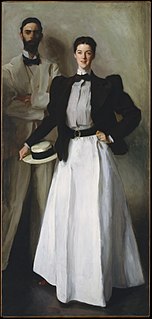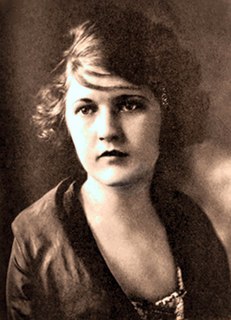Related Research Articles

A petticoat or underskirt is an article of clothing, a type of undergarment worn under a skirt or a dress. Its precise meaning varies over centuries and between countries.

Fashion in the 1890s in European and European-influenced countries is characterized by long elegant lines, tall collars, and the rise of sportswear. It was an era of great dress reforms led by the invention of the drop-frame safety bicycle, which allowed women the opportunity to ride bicycles more comfortably, and therefore, created the need for appropriate clothing.

Victorian dress reform was an objective of the Victorian dress reform movement of the middle and late Victorian era, led by various reformers who proposed, designed, and wore clothing considered more practical and comfortable than the fashions of the time.

Bloomers, also called the bloomer, the Turkish dress, the American dress, or simply reform dress, are divided women's garments for the lower body. They were developed in the 19th century as a healthful and comfortable alternative to the heavy, constricting dresses worn by American women. They take their name from their best-known advocate, the women's rights activist Amelia Bloomer.

Artistic Dress was a fashion movement in the second half of the nineteenth century that rejected highly structured and heavily trimmed Victorian trends in favour of beautiful materials and simplicity of design. It arguably developed in Britain in the early 1850s, influenced by artistic circles such as the Pre-Raphaelites, and Dress Reform movements. It subsequently developed into more specific categories such as Aesthetic Dress and Künstlerkleid on the continent.

1850s fashion in Western and Western-influenced clothing is characterized by an increase in the width of women's skirts supported by crinolines or hoops, the mass production of sewing machines, and the beginnings of dress reform. Masculine styles began to originate more in London, while female fashions originated almost exclusively in Paris.

A dress is a garment traditionally worn by women or girls consisting of a skirt with an attached bodice. It consists of a top piece that covers the torso and hangs down over the legs. A dress can be any one-piece garment containing a skirt of any length, and can be formal or casual.
Sibyls were oracular women believed to possess prophetic powers in ancient Greece.

Unisex clothing is best described as clothing designed to be suitable for both sexes in order to make men and women look similar. The term unisex was first used in 1968 in Life, an American magazine that ran weekly from 1883 to 1972.

Babani, founded in Paris in 1894 by Vitaldi Babani, was a fashion house based on the Boulevard Haussmann specialising in imported exotic goods, including artworks and handicrafts, and from the 1910s onwards, original garments inspired by their imported merchandise. The business closed in 1940.

The Lily was the first U.S. newspaper edited by and for women. It was published from 1849 to 1853 by Amelia Jenks Bloomer (1818–1894), before she sold the newspaper to Mary Birdsall in 1854. While the newspaper initially focused on temperance, it soon broadened its focus to include the many issues of women’s rights activists in the 1850s. It grew in its distribution as a result of its discussion of bloomers, a comfortable fashion popularized by Bloomer in the paper.

A sailor dress is a child's or woman's dress that follows the styling of the sailor suit, particularly the bodice and collar treatment. A sailor-collared blouse is called a middy blouse. In early 20th-century America, sailor dresses were very popularly known as Peter Thomson dresses after the former naval tailor credited with creating the style.

The Chapeau à la Paméla, Pamela hat or Pamela bonnet described a type of straw hat or bonnet popular during the 1790s and into the first three quarters of the 19th century. It was named after the heroine of Samuel Richardson's 1741 novel Pamela; or, Virtue Rewarded. While Pamela hats and bonnets underwent a variety of changes in shape and form, they were always made from straw. The mid-19th-century version of the Pamela hat was a smaller version of an early 19th-century wide-brimmed style called the gipsy hat.

Belle Armstrong Whitney, who also used the pen name Dinah Sturgis, was an American writer and "fashion expert", based in Paris.

Harriet Newell Austin was an American hydrotherapist, author, and dress-reform advocate. She was the designer of the "American costume," a style of dress meant to promote women's health.

Lydia Sayer Hasbrouck was an American hydrotherapist, an advocate for women's dress reform, and the founder and editor of The Sibyl, a periodical devoted to that attire reform topic. Elected to the Middletown, New York, Board of Education in 1880, she was one of the first women to hold elected office in New York.

Women's apparel in the early 20th century was often costly, inconvenient, and weighed heavily in regards to male courtship. Despite the social pressures of normative feminine dress, some women, specifically those involved in the Women's Suffrage Movement, were intent on rebelling against the standards of women's dress. However, the 1920s was not the first decade to reject impractical female apparel. The Victorian dress reform paved the way for the more progressive and more politically aggressive women of the 1920s, though the validity of such reforms, the New Woman in particular, has been criticized for emphasis on female empowerment through dress and manner rather than political efforts–noting a decline in American feminism in the 1930s and 1940s when fashions forged in the 1920s dress movement became more widely normalized and, in some ways, reverted to more restrictive dress and styles. Despite the subsequent decline in feministic ideology, the women of the 1920s' changing attitudes, reflected in their choice of apparel, had a lasting impression on modern feminist ideals that resurged in the 50s and 60s. The New Woman's moxie was paradoxically evident in her lack of charm, exhibiting short bobbed haircuts, heavier makeup, and boyish frames. It may seem as though the flapper mirrored a rebellion against femininity, but it was actually quite the opposite; it was meant to make the modern woman's life easier. The flapper's simplistic, straight-lined style was popularized by Coco Chanel, who's somewhat ironically remembered as "fashionable without being forward," as a way of liberating women the impractical designs that hindered modern women's ability to engage in physical activities. "The newfound freedom to breathe and walk encouraged movement out of the house, and the Flapper took full advantage.” Popular accessories now viewed as classics, such as strings of pearls and petite handbags, can also be traced back to the simplistic vision of Coco Chanel. Other successful accessory designers of the Roaring 20s include that of Cartier and "strap bracelets" and Miriam Haskell with her "fashion jewelry", but wealth wasn't a necessity for obtaining the flapper's look. Magazines provided sewing patterns to mimic chic Parisian trends, which fast-tracked the look's popularity by making them easily accessible to all those with a needle and thread, the common woman. However, while standardizing practical women's attire promoted movement, it was also seen as highly provocative, as the new dress served as a symbol of sexual freedom as well as an indicator of supposed declining morals. Flappers invested more importance on fun and panache than they did in moral character, idolizing figures such as Zelda Fitzgerald, wife of Modernist author F. Scott Fitzgerald, who was known for her flair, wit, and personal accomplishments as a writer and a professionally trained ballet dancer. Completing her own American novel, Save Me the Waltz, in 1932, Zelda epitomized the mantra that inspired the New Woman's change in apparel: that "a woman can do anything a man can do" without compromising her femininity. The flapper "smoked, drank, swore, drove fast, professed free love, and used makeup," and exercised sexual independence–re-positioning herself as an indelible force in Western society.

Swedish Dress Reform Association was a Swedish women's association, active from 1886 to 1903. It was a part of the Victorian dress reform, and worked to reform women's dress toward a more healthy and comfortable one, including abolishing the corset. The movement attracted a lot of attention and achieved some success during its duration, such as making corsets unfashionable among school girls.
Helen Lathrop Gilbert Ecob was an American writer and suffragist. Ecob was well known for her 1892 book on women's fashion reform, The Well-Dressed Woman: A Study in the Practical Application to Dress of the Laws of Health, Art, and Morals. She was involved in dress reform and women's suffrage throughout her life.
References
- ↑ Cunningham, Patricia A (2003). Reforming women's fashion, 1850-1920 : politics, health, and art. Kent, Ohio: Kent State University Press. Libris länk. ISBN 0873387422
- ↑ Cunningham, Patricia A (2003). Reforming women's fashion, 1850-1920 : politics, health, and art. Kent, Ohio: Kent State University Press. Libris länk. ISBN 0873387422
- ↑ "The Original 'Bloomer Girls'". Nineteenth Century Dress Reform in Pictures. Retrieved January 15, 2018.
- ↑ "Dress Reformer - Lydia Sayer". Women of the Hudson Valley. Retrieved January 14, 2018.
- ↑ The Sibyl, July 15, 1859, pp. 588–89.
- ↑ Cunningham, Patricia A (2003). Reforming women's fashion, 1850-1920 : politics, health, and art. Kent, Ohio: Kent State University Press. Libris länk. ISBN 0873387422